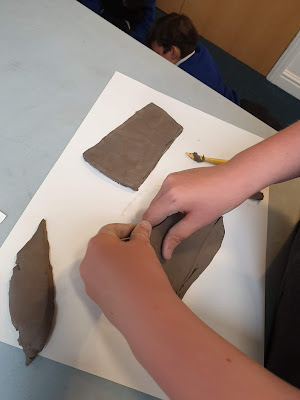Trip to Carlisle 16th April, 2019 and message from Ken, Creative Conversations
 |
| Carlisle Coat of Arms, Tullie House |
Today we went to Prism Arts Carlisle for our last visit, where we met up with our friends again from the Creative Conversations group.
Jac, our artist, told us that we were now in the last phase of our project moving towards each group designing and making individual banners to be displayed in Carlisle Library in September.
Jac told us a little about the history of the development of banners. We learned that banners are a form of communication. Whether it is today or 150 years ago, groups or organisations with a marching tradition have made banners to identify themselves and what they stand for.
Stephen White, historian from Carlisle Library had told us that before 1832 being a member of a trade society and meeting together was illegal. Those that did - the Chartists - all had banners to identify who they were and what they stood for. These may have started as a small wall hanging then sewn onto a bigger piece of material, then painted. Thousands of Chartists banners were made yet none survive.
These banners can contain a lot of information and can be 'read' by historians in much the same way as documents.
We then went onto look in more detail at the banner produced by the Carlisle Association of Cotton Spinners - the centre piece being originally an apron worn by a local cotton spinner who celebrated the passing of the 1832 reform act in a procession through Carlisle.
 |
| Cotton Spinners Quilt - Tullie House website |
These were covered in more detail in the session but briefly for the blog and relevant to our project, we can see a cotton tree and ship. These relate to the trade triangle and the slave trade - Alan from the Beacon Museum had told us that this was the import of raw cotton from the slave plantations of the southern United States and the export of finished cotton around the world, in particular in Carlisle's case the export of plain dyed fabrics being sent back to the plantations and being worn by the slaves. (Please see earlier post on the Beacon visit for more information on the slave trade).
Also there is a spinning machine, which converted raw cotton into yarn for the hand loom weavers,
a child - a little girl - a reminder that many of the workers were children. Her hand being held by a male figure - this gesture reflecting the hierarchical way workforce was organised, many of children being children of adult workers or even as we now know orphans.
There is also the coat of arms. This we learned refers to the shield within the coat of arms but might also refer to the surcoat worn over armour - used to identify the wearer in battle or identify the dead on battlefields.
Symbolism again is contained within the shield and the coat of arms, for example the colours silver or white may mean peace and sincerity, blue - truth and loyalty. Animals represented may indicate courage for example a lion.
We then looked at the examples of personal shields the Distington children had made following their visit to Lowther Castle and Katie showed us examples from past projects and described what they represented and symbolised.
We then visited Tullie House to see the waistcoat made for and worn by Jonathan Dodgson Carr who founded Carrs Biscuit works.
 |
| Travis reading out the details for us all in a lovely clear voice |
As a Quaker, Carr was very keen on social reform and looked after his workers well. He was involved in the founding of the Cumberland Building Society, the fight against the slave trade and the temperance movement. It is made of brown velvet and decorated with ears of wheat and the word "Free" to highlight his role in the fight to repeal the Corn Laws and the promotion of free trade.
Carr used the symbolism depicted on the waistcoat to identify what he stood for.
Whilst at the Museum we were able to see the painting of Carlisle Canal Basin painted about 1823 by William Brown. David Ramshaw had told us this was of the view across Carlisle canal basin with seven rigged boats and several rowing boats moored at its far side. In the foreground a solitary figure stands upon a wooden jetty, a long pole in his hands. The city of Carlisle lies in the distance, hills rising beyond.
We were also able to see some original carved wooden printing blocks from Stead McAlpin
Also Alison from the Creative Conversations group brought in a printing block, made from metal thought to have been used at Stead McAlpin. It was lovely to be able to handle this and see the fine detail and imagine the work involved in making such an item. Thank you Alison for sharing this with us.
Sadly Ken, from Creative Conversations was unable to join us as he had been taken seriously ill.
Ken is an active member of our group and in wanting to wish him a speedy recovery, we did what we do best! We got creative and made him not one but several cards to let him know he was missed and hoping he will be back with us soon.
Amanda who leads the Creative Conversations group visited Ken and says ' Ken LOVED all the childrens messages and illustrations. He smiled and laughed and said he would look at it every day to make him feel happy.
So please
thank them for taking the time to draw and write so thoughtfully. Ken
says he is getting stronger every week and hopes to see the children at
the library opening.'








Comments
Post a Comment